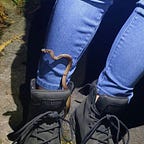【Welfare Assessment 動物福利評估表】For Zoo & Aquarium Reptiles 展演爬行動物
Since many of you seem to be interested in our previous attempt in drafting a welfare assessment sheet for aquarium fish, I’m guessing that you may enjoy the one for zoo and aquarium reptiles as well. Thus, I would like to share the collective effort in creating a welfare assessment sheet for exhibited reptiles from me and my Colleague H, who has abundant experience and knowledge in reptile care at zoos and global exotic pet trade (secretly one of the great people who I admire quite a lot). Perhaps I’m getting slightly too confident, but I think it’s worth sharing this in both English and Traditional Chinese in the hope that more people can access the content and maybe spark some discussion.
由於似乎有不少人對前一篇我們製作的水族館魚類的動物福利評估表草稿蠻有興趣的,我猜你們或許也會想看看展演爬行動物的動物福利評估。因此,我想分享另一份我與具有豐富展演爬蟲照養與國際特寵貿易經驗與知識的同事H(他也是其中一個我偷偷欣賞的厲害人人之一),共同設計出給展演爬行動物的動物福利評估表。不知道會不會太過自信,但我覺得想嘗試以雙語的方式分享這次的內容,想說這樣或許能讓更多人看到這份努力並促進交流。
The original design of this assessment was structured as other Quality of Life Assessments for mammals and birds at a zoo. However, we believe the assessment will probably be more comprehensive if we extrapolate the structure of the aquarium fish assessment. So, that is mainly what we did. Furthermore, we round the final score up to 150, which is the same as that of the fish assessment, so that any organisation wish to reallocate their resources based on the results of the assessments can easily compare the scores from the two taxa.
這份評估表的初版架構是某座動物園給哺乳類與鳥類的生活品質評估表。然而,我們認為如果採用水族館魚類動物福利評估表的架構,這份評估會更全面。於是,這也是我們這次所做的最主要修改。另外,我們把這份評估表的滿分也湊到了跟水族館魚類福利評估一樣的150分,以讓想根據評估結果重新分配照管資源的單位可以輕鬆比較兩個類群的評分結果。
(The Traditional Chinese version will be after the English version)
(繁體中文版放在英文版之後)
ENGLISH VERSION
Since we spent quite some time and effort in creating this assessment, please do not use it without our permission or sharing it without specifying its source. Nonetheless, if anyone is interested in putting it into application, feel free to contact us for further discussions, collaborations and etc..
繁體中文版本
不得不說這份評估表的製作花了我們許多時間心力,所以還請大家不要未經作者許可就擅自使用,也請不要做未標明出處的分享。如果真的有人對評估表的應用有興趣,歡迎聯絡我們進行後續討論或合作方式等等。
References/參考資料:
Welfare Quality Network | Assessment Protocols. (n.d.). https://www.welfarequalitynetwork.net/en-us/reports/assessment-protocols/
Warwick, C., Arena, P., Lindley, S., Jessop, M., & Steedman, C. (2013). Assessing reptile welfare using behavioural criteria. In Practice, 35(3), 123–131. https://doi.org/10.1136/inp.f1197
Hewitt, L., & Small, A. (2021). Welfare of Farmed Crocodilians: Identification of potential Animal-Based Measures using elicitation of expert opinion. Animals, 11(12), 3450. https://doi.org/10.3390/ani11123450
Benn, A. L., McLelland, D. J., & Whittaker, A. L. (2019). A Review of Welfare Assessment Methods in Reptiles, and Preliminary Application of the Welfare Quality® Protocol to the Pygmy Blue-Tongue Skink, Tiliqua adelaidensis, Using Animal-Based Measures. Animals, 9(1), 27. https://doi.org/10.3390/ani9010027
Whittaker, A. L., Golder-Dewar, B., Triggs, J. L., Sherwen, S., & McLelland, D. J. (2021). Identification of Animal-Based Welfare Indicators in captive reptiles: a Delphi Consultation survey. Animals, 11(7), 2010. https://doi.org/10.3390/ani11072010
Baines, F. M., Chattell, J., Dale, J., Garrick, D., Gill, I., Goetz, M., … & Swatman, M. (2016). How much UVB does my reptile need? The UV-Tool, a guide to the selection of UV lighting for reptiles and amphibians in captivity. Journal of Zoo and Aquarium Research, 4(1), 42–63.
https://assets.speakcdn.com/assets/2332/aza-accreditation-standards.pdf
